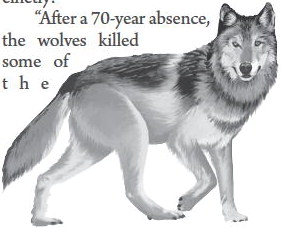Wolves in Yellowstone


We know what Mother Nature can do to ruin your day. Nature is all that is good about benign streams, flowing meadows, picturesque landscapes, turning leaves and peaceful mountain trails. Nature, too, can be floods, tornados, typhoons, hurricanes, and wildfires caused by lightning strikes. We just saw Ian give the state of Florida the back of its hand as if the Sunshine state had committed an unpardonable sin somewhere along the way. I prefer the good stories that nature brings about. Spring flowers, falling leaves and those peaceful interludes with love and song blending into unforgettable moments of inspiration.
The survival of wildlife for example, reminds us that nature seems to find an equitable balance. When wolves were reintroduced to Yellowstone Park in 1995, the elk, easy prey for the wolves, learned to graze when the wolves were sleeping. That turned out to include the nighttime. There had to be a significant number of dissenters regarding the bringing back of the wolves, but recently, someone sent along a video which truly is mind boggling. If you had asked me about the reintroduction plan 25 years ago, I would have instinctively voted against a return of the wolves. Wolves are dastardly killers, aren’t they? Certainly, they can be, but there was a redeeming upside to the return of the wolves.
Here is what the wolves return did for Yellowstone, which I learned about from a video sent along by a friend. The video script explained succinctly: “After a 70-year absence, the wolves killed some of the deer as expected. That was not a bad thing in that the deer had become so overpopulated that they had reduced much of the vegetation.
“As soon as the wolves arrived, even though they were few in number, they started to have the most remarkable effects. First, of course, they killed some of the deer, but that wasn’t the major thing. Much more significantly, they radically changed the behavior of the deer.
“The deer started avoiding certain parts of the park – the places where they could be trapped most easily – particularly the valleys and the gorges, and immediately those places started to regenerate. In some areas, the height of the trees quintupled in just six years. Bare valley sides quickly become forests of aspen and willow and cottonwood. And as soon as that happened, the birds started moving in. The number of songbirds and migratory birds started to increase greatly.
“The number of beavers started to increase because beavers like to eat the trees. And beavers, like wolves, are ecosystem engineers. They created niches for other species. And the dams they built in the rivers provided habitats for otters and muskrats and ducks and fish and reptiles and amphibians.
“The wolves killed coyotes, and as a result of that, the number of rabbits and mice began to rise, which meant more hawks, more weasels, more foxes, and more badgers. Ravens and bald eagles came down to feed on the carrion that the wolves had left. Bears fed on it, too. And their population began to rise as well partly also because there were more berries growing on the regenerating shrubs. The bears reinforced the impact of the wolves by continued from page
killing some of the calves of the deer.
“But here’s where it gets really interesting. The wolves changed the behavior of the rivers. They began to meander less. There was less erosion. The channels narrowed. More pools formed. More riffle sections. All of which were great for wildlife habitats.
“The rivers changed in response to the wolves. And the reason was that the regenerating forests stabilized the banks so that they collapsed less often. So, the rivers became more fixed in their course. Similarly, by driving the deer out of some places, and the vegetation recovering on the valley side, there was less soil erosion because the vegetation stabilized that as well.
“The wolves, small in number, transformed not just the ecosystem of the Yellowstone National Park – this huge area of land… but also, its physical geography.”
This story is a moving treatment which makes you realize that we should appreciate nature more, but also that we should give more credence to what the scientists are telling us about global warming. There are a lot of things we conveniently ignore now that may be costly to those we leave behind.








out of
Posted on